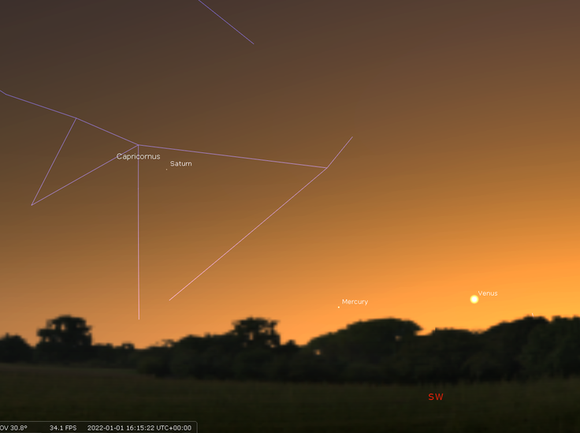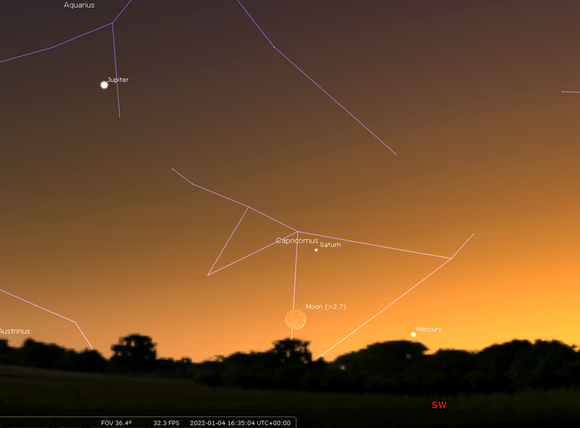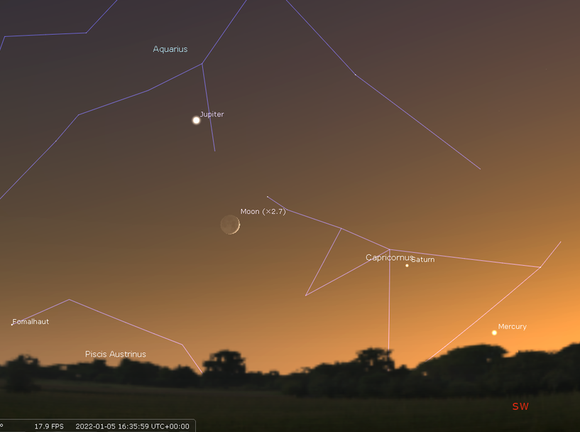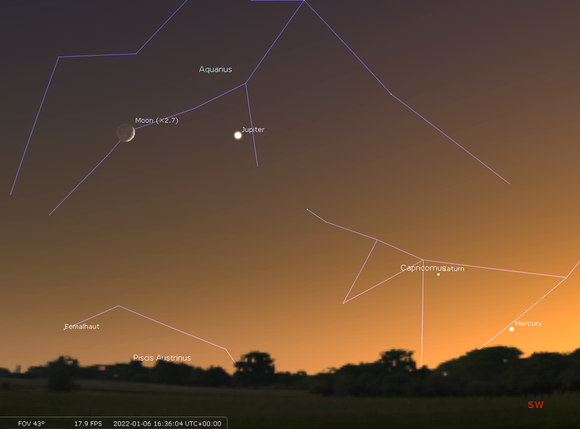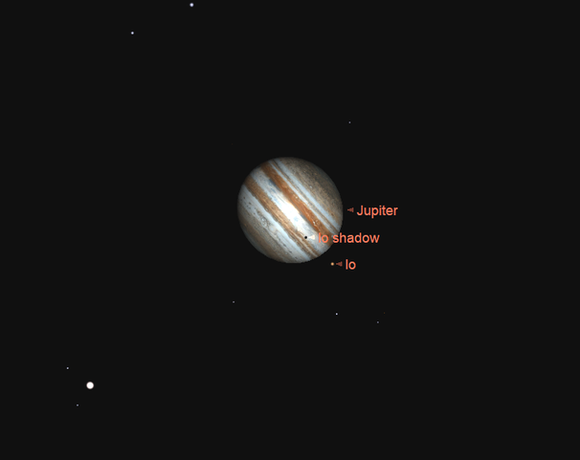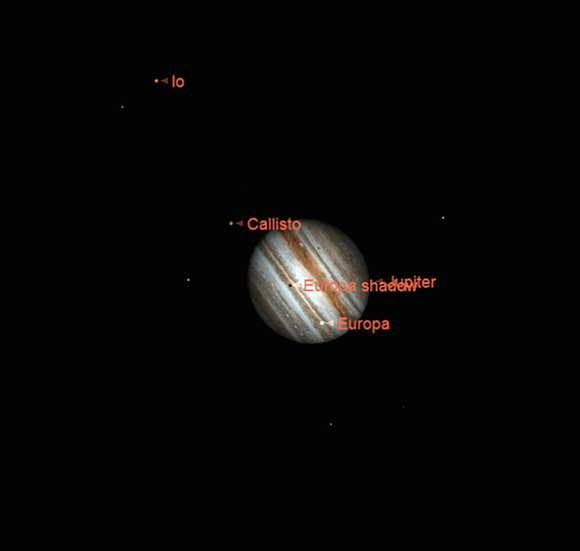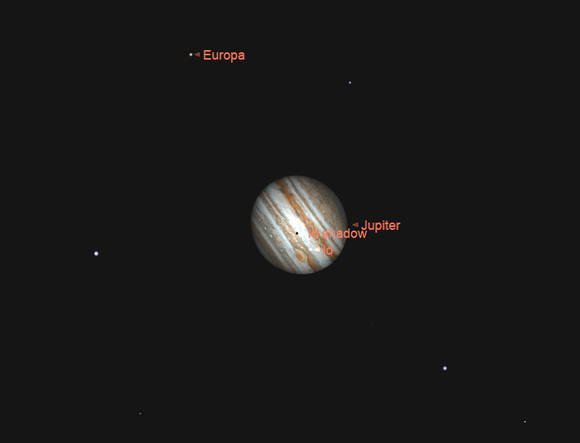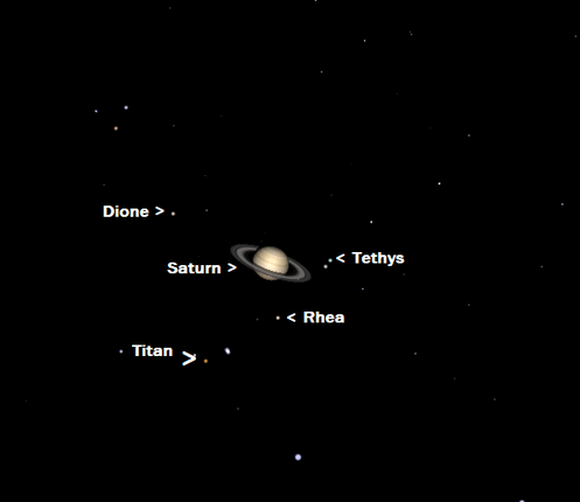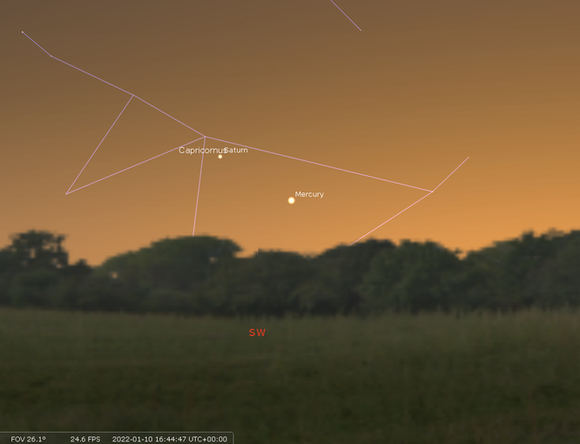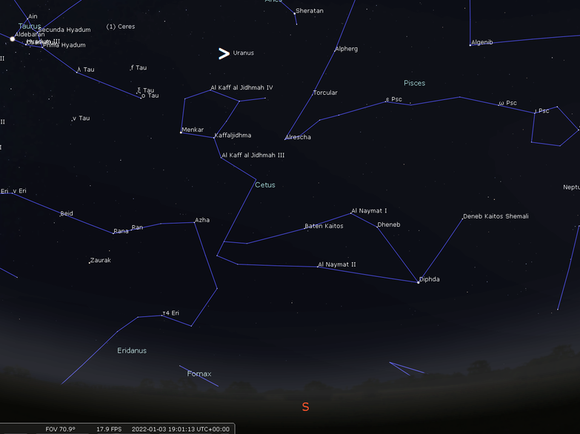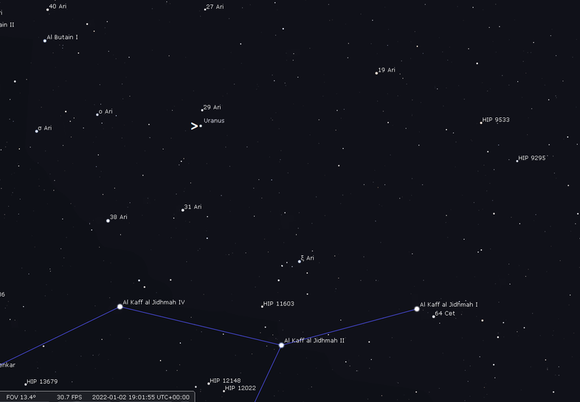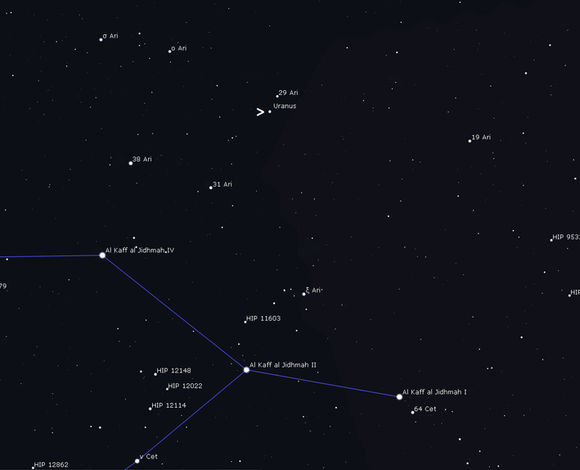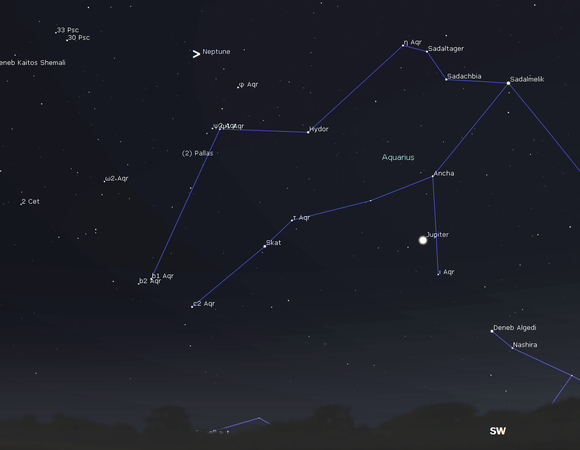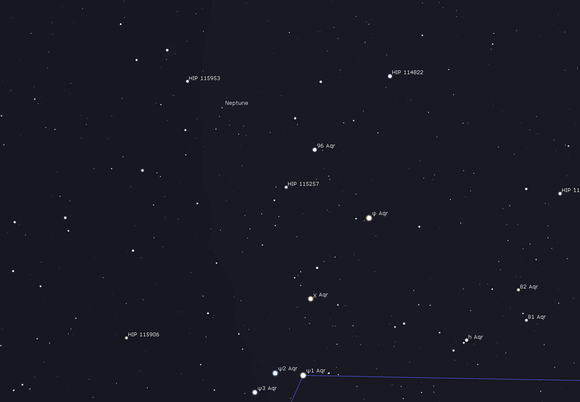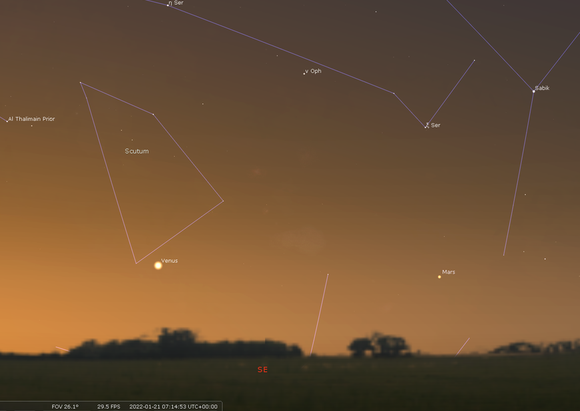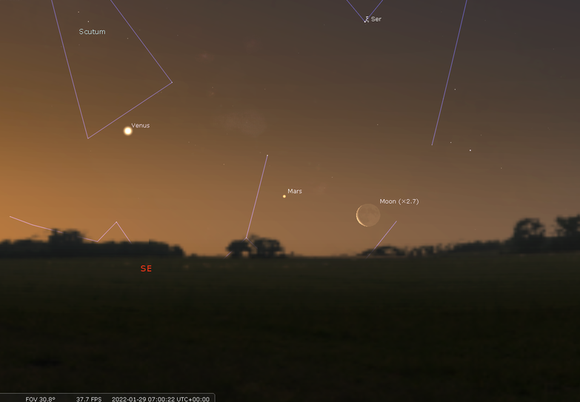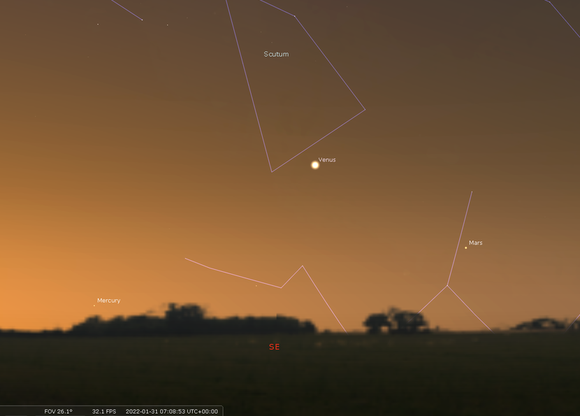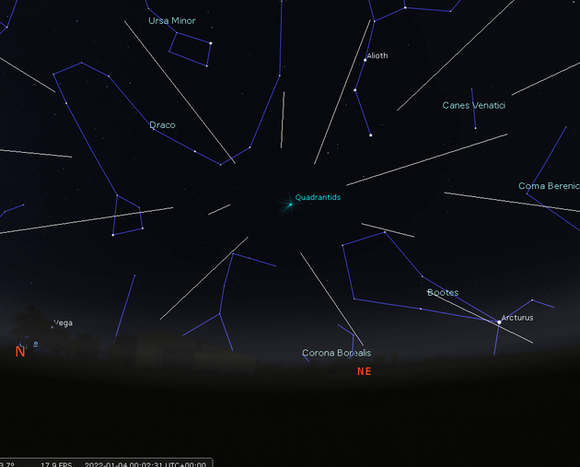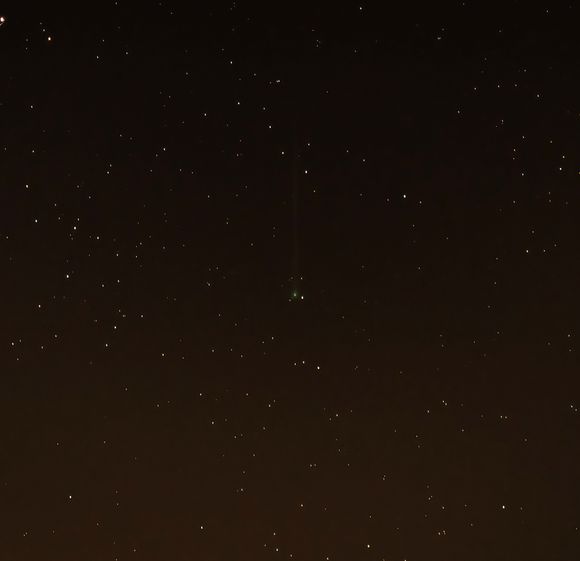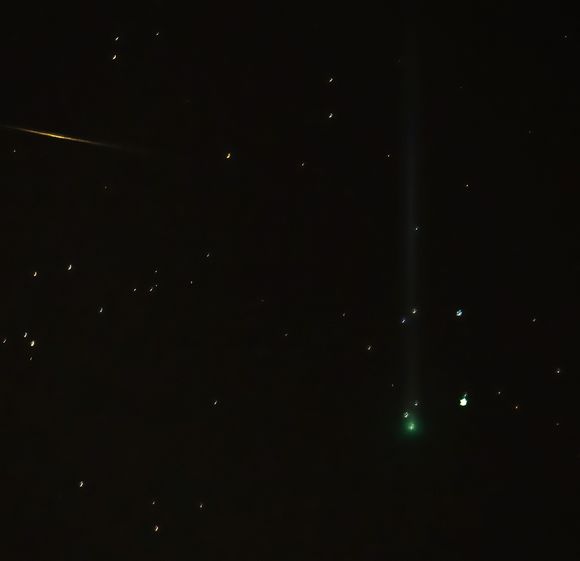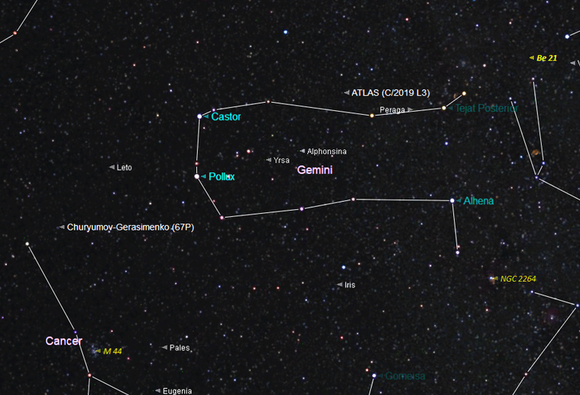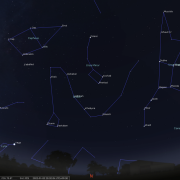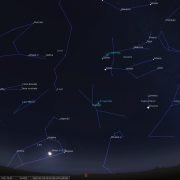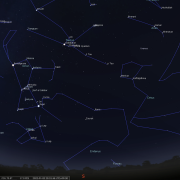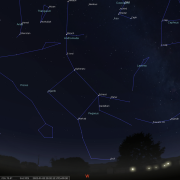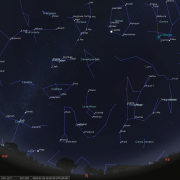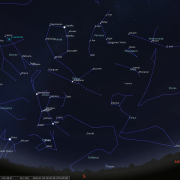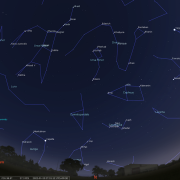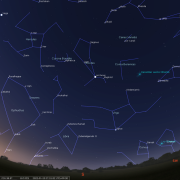In this month's Sky Notes:
Planetary Skylights - Brief
 Venus, sometimes called the 'evening' or 'morning' star, adopts both guises over the course of January. It is briefly visible in the evening twilight sky for the first few days of January around 7 degrees above the SW horizon, but then switches allegiance, going through inferior conjunction on Jan 9th, becoming an early morning object by mid January. At magnitude -4.3 Venus is unmistakable. Viewing will be poor due to the low altitude, but you may discern a distinct crescent phase through the eyepiece. (cont in dawn planets)
Venus, sometimes called the 'evening' or 'morning' star, adopts both guises over the course of January. It is briefly visible in the evening twilight sky for the first few days of January around 7 degrees above the SW horizon, but then switches allegiance, going through inferior conjunction on Jan 9th, becoming an early morning object by mid January. At magnitude -4.3 Venus is unmistakable. Viewing will be poor due to the low altitude, but you may discern a distinct crescent phase through the eyepiece. (cont in dawn planets) Mercury climbs higher into the evening twilight sky, (still only 8 degrees), reaching greatest elongation east (19 degrees) from Sun on January 7th peaking in altitude a tad under 10 degrees. It then wastes little time in the evening twilight, dropping back to the horizon and reaches inferior conjunction once again on Jan 23rd. You will locate the elusive world around 40 minutes after sunset in the evening twilight above the SW horizon. At magnitude -0.7 Mercury is brightest during the first week of the New Year, thereafter the brightness tails off. After passing thru' inferior conjunction, Mercury re-emerges in the dawn sky at the very end of January, by then a +1.3 magnitude object. Look for it extremely low in the SE sky 40 minutes before sunrise.
Mercury climbs higher into the evening twilight sky, (still only 8 degrees), reaching greatest elongation east (19 degrees) from Sun on January 7th peaking in altitude a tad under 10 degrees. It then wastes little time in the evening twilight, dropping back to the horizon and reaches inferior conjunction once again on Jan 23rd. You will locate the elusive world around 40 minutes after sunset in the evening twilight above the SW horizon. At magnitude -0.7 Mercury is brightest during the first week of the New Year, thereafter the brightness tails off. After passing thru' inferior conjunction, Mercury re-emerges in the dawn sky at the very end of January, by then a +1.3 magnitude object. Look for it extremely low in the SE sky 40 minutes before sunrise. January 1st @ 16:15hrs GMT (click for full image)
 Jupiter becomes increasingly more challenging to observe with satisfaction as we head through January, so UK observers will have to make the most of any observing opportunities that present themselves early in the New Year when Jupiter is a little higher. To the naked eye Jupiter remains a conspicuous object (mag -2.1) above the SW horizon as dusk falls sitting amongst the faint stars of Aquarius. View on the 5th, 6th and 7th when a waxing crescent moon passes through the area. Binoculars are sufficient to reveal the Galilean moons as specks of light close by Jupiter, but a telescope is required to fully appreciate the Jovian system.
Jupiter becomes increasingly more challenging to observe with satisfaction as we head through January, so UK observers will have to make the most of any observing opportunities that present themselves early in the New Year when Jupiter is a little higher. To the naked eye Jupiter remains a conspicuous object (mag -2.1) above the SW horizon as dusk falls sitting amongst the faint stars of Aquarius. View on the 5th, 6th and 7th when a waxing crescent moon passes through the area. Binoculars are sufficient to reveal the Galilean moons as specks of light close by Jupiter, but a telescope is required to fully appreciate the Jovian system.
As Jupiter drops down ‘seeing’ will become increasingly unstable, but in moments of clarity Jupiter is a fine sight through the eyepiece. The disk is noticeably oblate spanning almost 40 arc seconds. Apertures of 4" (100mm) and above may reveal the Great Red Spot (GRS) feature which is on view on the following dates between 17:30hrs and 18:30hrs; - Jan 2, 4, 7, 9, 14, 16, 19, 21, 26, 28 and 31st.
Jupiter is flanked by the Galilean moons' seen as specks of light close by. The 'dance' of the Galilean moons around the planet throws up a different configuration each night. If you have a 4" (100mm) aperture scope' and above, shadow transits of moons passing on the near side of Jupiter will be visible, jet black dots of varying size dependant on which moon is involved. The actual moons themselves are more difficult to spot as they pass in front of Jupiter, requiring larger apertures. There will be fewer opportunities in January, before Jupiter is lost next month, the most favourable shadow transits being Io - 8th @ 17:45hrs and the 31st @ 17:45hrs and Europa - 29th @ 17:45hrs.
 Saturn is now at the end of its apparition for this year and is lost to the SW horizon by mid January. If you want to view with a telescope do so on the first evening of the New Year around 17:30hrs. As Saturn sinks lower down it draws quite close to Mercury coming the other way. This will be a naked eye/binocular conjunction. View on Jan 10th @ 16:45hrs to spot them just above the SW horizon. Of the two, Mercury will be brightest appearing to the right of Saturn.
Saturn is now at the end of its apparition for this year and is lost to the SW horizon by mid January. If you want to view with a telescope do so on the first evening of the New Year around 17:30hrs. As Saturn sinks lower down it draws quite close to Mercury coming the other way. This will be a naked eye/binocular conjunction. View on Jan 10th @ 16:45hrs to spot them just above the SW horizon. Of the two, Mercury will be brightest appearing to the right of Saturn.
 Uranus will be at its most accessible throughout January, culminating due south during the mid evening period almost 54 degrees in altitude. Uranus is located in the southern reaches of Aries, (it's actually closer to the head of Cetus) well below the crooked line of stars marking Aries itself. This area of sky is largely devoid of naked eye stars so zeroing in on the exact location is quite a challenge. Roughly speaking it lies 10 degrees below the chief star in Aries - Hamal. The nearest apparent stars through binoculars are omicron Ari and 29 Ari, both at magnitude 5.7. Uranus currently sits beneath the latter. At magnitude +5.85 Uranus is technically visible to the naked eye, but only from very dark locations and with good knowledge of the stellar neighbourhood.
Uranus will be at its most accessible throughout January, culminating due south during the mid evening period almost 54 degrees in altitude. Uranus is located in the southern reaches of Aries, (it's actually closer to the head of Cetus) well below the crooked line of stars marking Aries itself. This area of sky is largely devoid of naked eye stars so zeroing in on the exact location is quite a challenge. Roughly speaking it lies 10 degrees below the chief star in Aries - Hamal. The nearest apparent stars through binoculars are omicron Ari and 29 Ari, both at magnitude 5.7. Uranus currently sits beneath the latter. At magnitude +5.85 Uranus is technically visible to the naked eye, but only from very dark locations and with good knowledge of the stellar neighbourhood.
At a distance of 2.8 billion Km (1.78 billion miles) not surprisingly the disk of Uranus appears rather small through a telescope; just 3.4 arc seconds and exhibits a bland, ghoulish grey/green lustre, even larger instruments of 200-300mm aperture show next to nothing on the disk. Scopes of 300mm+ will however reveal two of Uranus's moons; Oberon and Titania, if seeing is good.
 Neptune is now on the slippery slope down to the SW horizon and by the end of January observations will be limited to just 30 minutes from 18:00hrs. Therefore, if you wish to track down Neptune, do so early in the month as soon as darkness falls. Neptune will then be a respectable 30 degrees above the SSW horizon, located midway between the faint loop of stars marking the western fish in Pisces, and Aquarius. The nearest visible naked eye star to Neptune is phi Aqr at mag +4.2 located a few degrees to the SW. Through binoculars the nearest 'conspicuous star' is 96 Aqr. Neptune is currently at a distance from Earth of approximately 4.3 billion km (2.7 billion miles) and at magnitude +7.8 will require at least a decent pair of binoculars to spot it. In reality however, a telescope of 100mm aperture will be needed to positively identify the tiny blue/grey disk, which is less than 2 arc seconds across. See charts for location details.
Neptune is now on the slippery slope down to the SW horizon and by the end of January observations will be limited to just 30 minutes from 18:00hrs. Therefore, if you wish to track down Neptune, do so early in the month as soon as darkness falls. Neptune will then be a respectable 30 degrees above the SSW horizon, located midway between the faint loop of stars marking the western fish in Pisces, and Aquarius. The nearest visible naked eye star to Neptune is phi Aqr at mag +4.2 located a few degrees to the SW. Through binoculars the nearest 'conspicuous star' is 96 Aqr. Neptune is currently at a distance from Earth of approximately 4.3 billion km (2.7 billion miles) and at magnitude +7.8 will require at least a decent pair of binoculars to spot it. In reality however, a telescope of 100mm aperture will be needed to positively identify the tiny blue/grey disk, which is less than 2 arc seconds across. See charts for location details.
Dawn Planets


 Mars is visible in the dawn sky, low to the SE horizon. View around 07:00hrs GMT to spot the red planet, which at mag +1.5 should be readily visible thru' binoculars, if not the naked eye. Mars wanders into Sagittarius by Jan 19th having been located in the non zodiacal constellation of Ophiuchus. By Jan 20th Mars has been joined by Venus, in the guise of 'brilliant morning star' and very much the most dominant planet visible in the dawn sky having just passed though inferior conjunction. On Jan 26th Mars passes just north of the Lagoon nebula or M8, but this will be challenging for observers in the Northern Hemisphere. A waning crescent moon lies off to the right of Mars on Jan 29th by some 2.4 degrees. By the last few days of January Mercury also pops into view just above the ESE horizon, commencing a decent morning apparition. It will be more favourably placed in February, but the observer will still require a clear unobstructed horizon to spot this elusive wanderer. View shortly after 07:00hrs.
Mars is visible in the dawn sky, low to the SE horizon. View around 07:00hrs GMT to spot the red planet, which at mag +1.5 should be readily visible thru' binoculars, if not the naked eye. Mars wanders into Sagittarius by Jan 19th having been located in the non zodiacal constellation of Ophiuchus. By Jan 20th Mars has been joined by Venus, in the guise of 'brilliant morning star' and very much the most dominant planet visible in the dawn sky having just passed though inferior conjunction. On Jan 26th Mars passes just north of the Lagoon nebula or M8, but this will be challenging for observers in the Northern Hemisphere. A waning crescent moon lies off to the right of Mars on Jan 29th by some 2.4 degrees. By the last few days of January Mercury also pops into view just above the ESE horizon, commencing a decent morning apparition. It will be more favourably placed in February, but the observer will still require a clear unobstructed horizon to spot this elusive wanderer. View shortly after 07:00hrs.
Finally, Earth reaches perihelion and is closest to the Sun on Jan 4th this year, a distance of 0.983 AU or 147,100,100 km (92m million miles). The Full Moon on January 17th is also this year's smallest
Meteors - The Quadrantids.

The start of the New Year brings with it one of the top three meteor showers - the Quadrantids, with a peak rate topping 100. The Quadrantids are the least observed of the 'big three' meteor showers, factors such as timing, weather and peak duration often at play here. At least this year skies will be dark with the Moon well out of the way. The Quadrantids are active from Jan 1st - Jan 6th, a relatively short window, with the peak occurring at 20:40hrs GMT on Jan 3rd. On the face of it this sounds ideal for UK observers, however the radiant will be rather low to the NW and so better viewing will be had in Asia and Eastern Europe. The 'peak' generally only lasts 3 to 5 hours, so UK observers should try their luck towards midnight and into the early hours of the 4th, by which time the radiant of the shower will be higher in the NNE sky.
The Quadrantids are named for the now defunct constellation of Quadrans Muralis, which was removed from sky charts in 1922, but used to lie at the junction between Hercules, Bootes and Ursa Major. This radiant position is located low to the N at the time of the peak, so do not concentrate on this aspect, but instead 40-60 degrees (3 hand spans) either side and mid way up in the sky. UK observers will not register anything like ZHR numbers of 100 -120, but if conditions are clear around the midnight hour (especially after) on Jan 3/4, you could witness a very respectable 40-60 per hour. The good thing about meteor shower observing is that you do not require any additional optical assistance, just your eyes, so wrap up warmly and good hunting
January 2022 Comets
January skies still contain a couple of comets available for UK observers to track down with large binoculars, small telescope, or imaging devices. None of them are going to blow your mind. A few society members did spot Comet (A1 2021 Leonard) in December before it tracked too far south, Richard Randle managing to capture it in pre-dawn sky. see below
Comet 67P/Churyumov-Gerasimenko is forecast to reach mag +9 as it tracks through northern Cancer around 48 degrees up in the SE by midnight. Comet 67P/C-G is one of the best-studied comets; you will recall ESA's Rosetta spacecraft rendezvoused with it in 2014, sending the Philae lander to the comet’s surface before the year's end. Overall, the spacecraft travelled with the comet for two years.
Comet 19P Borrelly is also predicted to reach mag +9, maybe even a tad brighter. It spends most of January tracking northwards through Cetus before entering Pisces at the end of the month. Having come closest to Earth on Dec 11th at 175 million km, comet Borrelly will reach perihelion on February 1st a bit less than 200 million km (1.31 AU) from the Sun.
Comet 2019 L3 (ATLAS) is yet another comet peaking in brightness around +9 magnitude. It is well placed for UK observers in January, tracking south-westwards up through Gemini. Comet 2019 L3 is a large comet - perhaps similar in size to comet Hale-Bopp back in 1997. Unfortunately the comet does not come close to Earth or the Sun;- 2.58 AU and 3.55 AU respectively (1 AU = 150 million km or 93 million miles), otherwise 2019 L3 may have really hit the headlines. It is closest to Earth on the 6th and reaches a distant perihelion on Jan 9th. By the New Year the comet will be almost 70 degrees in altitude and will be visible in modest scopes, perhaps sporting a stubby tail, which will be apparent in images.
For accurate charts and position of comets please visit https://theskylive.com
January 2022 Sky Charts
Additional Image Credits:
- Planets and Comets where not otherwise mentioned: NASA/ESA
- Sky Charts: Stellarium Software and Starry Night Pro Plus 8
- Log in to post comments

